- Author admin [email protected].
- Public 2023-12-16 16:46.
- Last modified 2025-01-23 11:22.
Fire blight is the worst disease a pear tree can suffer from. Because it will probably cost him his life. To avoid this, fire blight must not be given a chance to spread in the garden. This doesn't always work, but sometimes.

What do I do if there is fire on a pear tree?
Report fire blight immediately to the responsible environmental agency. If the infestation is mild, a deep cut back into the he althy wood can help. You have to clear a severely infested pear tree. Disinfect pruning tools with 70 percent alcohol. You should burn clippings if possible and never compost them.
What kind of disease is fire blight?
Fire blight is adangerous bacterial disease that affects rose plants It is caused by the bacterium Erwinia amylovora, which can penetrate through flowers and breathing openings on the underside of leaves. It spreads through the ducts, clogs them and blocks the supply of water and nutrients. Young trees die within a few weeks, while the death of older trees can take years. In addition to apples, quinces and cotoneasters, pears are particularly susceptible host plants. Firethorn and hawthorn are also often affected. Fire blight must be reported in this country.
How do I recognize fire blight on a pear tree?
Fire blight manifests itself with the following symptoms:
- Leaves and flowers turn black-brown
- they aremainly affected shoot tips
- they start to wilt, hang down
- finally disappear completely
- Bacterial slime becomes visible (small plugs)
- first milky white, later brownish
Final certainty as to whether it is actually fire blight can only be achieved through a laboratory test.
How can I fight fire blight?
As the flowering period begins, check your pear tree regularly for symptoms of the disease. CutIndividual affected shoots immediatelydeep into he althy wood. Disinfect scissors and other cutting tools (€39.00 at Amazon) with 70 percent alcohol before and after use. Burn the infected clippings if you can. If not, discuss further action with the responsible plant protection office. Under no circumstances should the clippings be composted. Carry out regular follow-up checks, including in the spring of the following year. You will most likely have to have a heavily infested tree cleared.
What promotes infection with fire blight?
There is an increased risk of infection from spring to autumn. Temperature values around 18 °Cand ahumidity around 70% promote the spread. Infestation with aphids and other suckers also contributes to the epidemic-like spread and infection of neighboring rose plants. Injuries to shoots and fruits form additional entry points for the bacterium.
How can fire blight be prevented?
In a private home gardenpreventive action can be taken against fire blighthardly. At least try to combat sucking pests (carriers) immediately. However, the best protection is to plant a less susceptible pear variety. For example 'Harrow Delight' or 'Champagne Bratbirne'.
Tip
Report a suspected case to the responsible office
Even if you are not entirely sure whether your pear tree is actually suffering from fire blight, you should report your suspicions to the responsible environmental agency. This is especially important if you live in a fruit-bearing region, as fire blight spreads rapidly through wind alone. It can lead to significant harvest losses or even destroy entire orchards.






